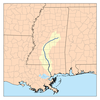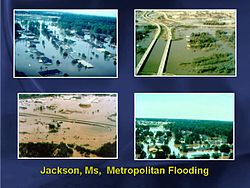 Flood waters inundated Downtown Jackson during the 1979 Easter flood. | |
| Meteorological history | |
|---|---|
| Duration | April 1979 |
| Overall effects | |
| Fatalities | 4 [1] |
| Areas affected |
Hinds,
Madison, and
Rankin counties,
Mississippi, U.S. Map showing the Pearl River in Mississippi. |
The 1979 Easter flood was one of the most costly and devastating floods to ever occur in Mississippi, United States, with $500–700 million in damages ($2.1 billion in 2020 dollars). [2] [3] It was the result of the Pearl River being overwhelmed by severe rain upstream. Floodwaters sent the Pearl River 15 feet above flood stage. More than 17,000 residents of Jackson, Flowood, Pearl, Richland, and other settlements in the Jackson metropolitan area were forced from their homes. The flooding of the Pearl River placed most of the streets of Jackson, the state's capital city, under several feet of water. [4] This flood resulted from a storm system that was the same storm system [5] [6] that, just a few days earlier, produced the Red River valley tornado outbreak that is particularly well-known because of the devastating Wichita Falls, Texas tornado that killed 42, injured over 1,700, left an estimated 20,000 homeless, and caused, in 1979 dollars, approximately $400 million in damages. [7]
The river
The Pearl River is 490 miles long. It begins in Winston County, Mississippi and ends at the Mississippi Sound. Northeast of Jackson, the man-made Ross Barnett Reservoir is formed by a dam in the Pearl River. It flooded due to abnormally high rainfall in the preceding months (up to 150% more than usual). [8] The water level reached a record-setting 43.28 feet on April 17, 1979. [9]

Present
Flood stage at Jackson in 1979 was considered to be 18 feet (relative to the gauge datum on Pearl River), but as of 2004, this stage was set as 28 feet. [1]
External links
- NBC News Update Easter 1979 broadcast which includes coverage of the 1979 Easter flood.
- National Weather Service Forecast Office: Jackson, MS
- [1]
- WLBT Archive: Flood of 1979
- Lessons of the 1979 Easter Flood
References
- ^
a
b Meteorologist-In-Charge in 1979.
"Excerpts from a preliminary report by the Meteorologist-In-Charge in 1979 to the Acting Director Southern Region of the National Weather Service dated April 20, 1979". National Weather Service Jackson.
{{ cite web}}: CS1 maint: numeric names: authors list ( link) - ^ 1634–1699: McCusker, J. J. (1997). How Much Is That in Real Money? A Historical Price Index for Use as a Deflator of Money Values in the Economy of the United States: Addenda et Corrigenda (PDF). American Antiquarian Society. 1700–1799: McCusker, J. J. (1992). How Much Is That in Real Money? A Historical Price Index for Use as a Deflator of Money Values in the Economy of the United States (PDF). American Antiquarian Society. 1800–present: Federal Reserve Bank of Minneapolis. "Consumer Price Index (estimate) 1800–". Retrieved February 29, 2024.
- ^ "NWS Jackson, MS 1979 Pearl River Flood". Archived from the original on 2014-08-09. Retrieved 2014-07-17.
- ^ "Facts | Pearl River Vision Foundation". www.pearlrivervisionms.com. Archived from the original on 2016-03-06. Retrieved 2016-02-15.
- ^ Hederman, T.M. Jr. (1979). The Great Flood: 1979. Hederman Brothers. p. 7.
- ^ "NWS Jackson, MS 1979 Pearl River Flood". Archived from the original on 2014-08-09. Retrieved 2023-05-27.
- ^ "Wichita Falls, TX Tornadoes (1900-Present)". Norman, OK Weather Forecast Office. National Weather Service. Retrieved 5 January 2022.
-
^ Service, US Department of Commerce, NOAA, National Weather.
"NWS Jackson, MS 1979 Pearl River Flood". www.srh.noaa.gov. Retrieved 2016-02-15.
{{ cite web}}: CS1 maint: multiple names: authors list ( link) - ^ Case, Bert (18 April 2014). "Case Files: Could the Easter flood of 1979 happen again?". WAPT. Retrieved 2016-02-15.